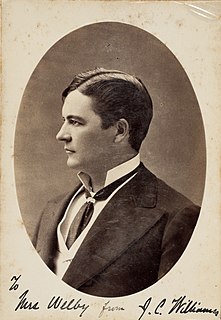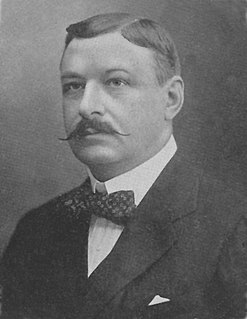
Lotus Thompson was an Australian actress of silent and sound films. Her film career began in Australia in 1921 and ended in California in 1949, during which time she appeared in 35 motion pictures. She died in California in 1963.
Gustave Adrian "Gus" Barnes was an English violinist, painter and sculptor with a significant career in South Australia, notably as curator at the Art Gallery.

James Cassius Williamson was an American actor and later Australia's foremost impresario, founding J. C. Williamson Ltd.

Cecil Lauriston Kellaway was a British/South African character actor. He was nominated for the Academy Award for Best Supporting Actor for both The Luck of the Irish (1948) and Guess Who's Coming to Dinner (1967).

George Musgrove was an English-born Australian theatre producer.

The Criterion Theatre was a theatre in Sydney, Australia which was built in 1886 by architect George R Johnson on the south east corner of Pitt and Park streets. It closed in 1935 and the building was demolished.
HMAS Goolgwai was an auxiliary minesweeper operated by the Royal Australian Navy (RAN) during World War II. She was launched in 1919 by Collingwood Shipbuilding Company at Collingwood, Ontario, Canada as Almeria. The ship operated in Australian waters from 1928, and was requisitioned by the RAN on 3 September 1939. She was returned to her owners in 1945 before being wrecked near Malabar, Sydney on 29 May 1955.
John Forde Cazabon was an English actor and stage writer whose career began in Sydney, Australia.

Trilby Clark was an Australian actress who appeared in British films beginning in the silent film era. She was a leading lady in British films during the 1920s and early 1930s.
Frank Beaumont "Beau" Smith, was an Australian film director, producer and exhibitor, best known for making low-budget comedies.

The Shadow of Lightning Ridge is a 1920 Australian silent film starring renowned Australian sportsman Snowy Baker. It has been called the most "Western"-like of the films Baker made in Australia.
Edward John Carroll, better known as E.J. Carroll, was an Australian theatre and film entrepreneur. He produced several films of Snowy Baker and Raymond Longford and helped establish Birch, Carroll and Coyle. Difficulties in securing international distribution for his films turned him away from production towards exhibition.
Samuel Lazar was an Australian theatre manager, producer of pantomimes and operas, and occasional actor.
Norman Chinner LRSM OBE was a South Australian organist and choirmaster.

Gustave Slapoffski was a British-born musician who performed as a violinist and conductor in Britain for two decades, followed by a conducting and film scoring career in Australia over the next three decades.
Nigel Tasman Lovell was an Australian stage, radio, film and television actor, and producer of opera and both stage and radio drama.
The Empire Theatre was a live music venue in Sydney for a few years before 1929 when it became a cinema. Around 1940 it had a dual role and by 1950 it was hosting various kinds of stage shows, increasingly musicals, and was finally destroyed by fire.
George Leitch was an English actor-manager and dramatist who had a substantial career in Australia.
Frederick Ward was an English-born actor and theatre manager in Australia. He founded Sydney's first repertory theatre.
George Gordon was a scenic designer and artist in Australia, described by one critic as "unquestionably the greatest scene painter that ever came to Australia". His father was in the same line of business and his son John "Jack" Gordon following the family tradition, was head of J. C. Williamson's scenic department for ten years.








